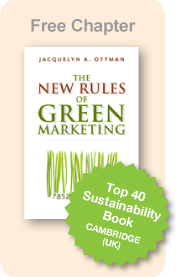Jacquie Ottman's
Green Marketing Blog
Is There a gDiaper in Your Baby’s Future?
July 31, 2008 by assistant

Can anyone topple the disposable diaper giants? The makers of gDiapers promise an attractive, well fitting, convenient diaper that can be flushed, home composted or tossed. All parents want a diaper that is easy to dispose of, safe, absorbent, and affordable. Can gDiapers provide all of this with less load on the planet? Let’s see how the facts stack up.
Diaper Facts: Sustainable vs. Conventional
There’s no doubt that disposables are the easiest to use. All you do is undo the plastic tabs and toss the diaper into the trash. Cloth diapers need to be rinsed, then tossed into a diaper container, then wash or picked up by a service.
gDiapers takes a hybrid approach. The outside layer consists of a colorful pant with a special patented liner. Next comes a flushable insert that gets dropped into the bowl then, with a couple of twists of a “swish stick” (provided) the insert can then be flushed. It is also possible that the inside liner may need to be washed.
The average cost for disposables according to The New Parents Guide is $50 to $80 dollars a month while cloth ranges from $25 to $60 dollars a month (including at-home washing). Out of pocket, gDiapers are the most expensive of the three (about 15% more than disposable over the life of your baby).
On the absorbency front, a typical disposable can hold up to three times more moisture than both the cloth and gDiapers, but at what cost? The gel core in disposable diapers is made of a synthetic chemical, sodium polyacrylate. Disposables also have a plastic outer layer, and may have irritating fragrances. gDiapers have the absorbency of the disposable diapers but without the plastic – and therefore better breathability for the baby’s bum. They also don’t present the guilt associated with dumping so many diapers in the trash.
Environmental Impact of Diapers
Ten thousand tons of disposable diapers get dumped into landfills every day—the equivalent of 3.4 billion barrels of oil and 250,000 trees. Along with the diapers comes the five million tons of untreated biological waste that can contaminate groundwater. In contrast, the waste from both cloth and gDiapers is treated just where it should be—in traditional wastewater treatment facilities. Although gDiapers still pale to cloth in terms of the amount of waste they produce, it is still significantly less than that of disposables and doesn’t consume the same amount of energy and cleaning supplies.
Water usage for cloth diapers and gDiapers is more difficult to compare. The efficiency of your toilet and washer can greatly impact the amount of water used—up to fifty gallons per load and seven gallons per flush. But, the smaller liner from gDiapers will still likely use less water overall.
Due to their popularity, disposable diapers are the third largest contributors to landfills, a fact that has not gone unnoticed by municipalities. However, with no viable alternative, there was little that legislators could do. Now, with gDiapers presenting a feasible alternative to both cloth and disposables, there is a strong possibility that laws will emerge in the future restricting the use of disposables. If this were to happen, gDiapers would become the diaper of choice for the next generation—and it is this likely possibility that makes the gDiapers so interesting.
Click here to join our mailing list.



 ShareThis
ShareThis

